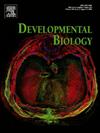晶状体调控基因驱动前眼发育的鉴定。
IF 2.5
3区 生物学
Q2 DEVELOPMENTAL BIOLOGY
引用次数: 0
摘要
晶状体发出的信号调节着眼睛发育的多个方面,包括眼睛大小的形成、前视杯中虹膜和睫状体的形成以及神经嵴细胞的迁移和分化。为了进一步了解晶状体调节眼睛发育的分子机制,我们对去除晶状体后的胚胎鸡视网膜进行了转录组分析。在摘除晶状体的眼睛中,与神经系统发育相关的基因被上调,但假定的睫状体和虹膜区域在摘除晶状体后并没有采用神经视网膜的身份。发现了与眼周间充质、角膜和前视杯发育有关的晶状体调节基因,包括以前未与眼睛发育有关的因素。出乎意料的是,在雄性和雌性鸡胚胎的视网膜中发现了转录组学差异,这表明从早期开始就存在性别二态性。胚胎鸡眼的原位杂交和胚胎小鼠和成人眼睛的数据集分析证实了候选基因的表达,包括多个WNT基因,在对眼睛前眼发育和功能重要的组织中。值得注意的是,典型WNT信号的药理激活恢复了晶状体缺失时眼睛的发育和大小。这些分析已经确定了参与眼睛发育的候选基因和生物学途径,为该领域的新研究提供了途径。本文章由计算机程序翻译,如有差异,请以英文原文为准。

Identification of lens-regulated genes driving anterior eye development
Signals from the lens regulate multiple aspects of eye development, including establishment of eye size, patterning of the presumptive iris and ciliary body in the anterior optic cup and migration and differentiation of neural crest cells. To advance understanding of the molecular mechanism by which the lens regulates eye development, we performed transcriptome profiling of embryonic chicken retinas after lens removal. Genes associated with nervous system development were upregulated in lens-removed eyes, but the presumptive ciliary body and iris region did not adopt a neural retina identity following lens removal. Lens-regulated genes implicated in periocular mesenchyme, cornea and anterior optic cup development were identified, including factors not previously implicated in eye development. Unexpectedly, transcriptomic differences were identified in retinas from male versus female chicken embryos, suggesting sexual dimorphism from early stages. In situ hybridisation of embryonic chicken eyes and analyses of datasets from embryonic mouse and adult human eyes confirmed expression of candidate genes, including multiple WNT genes, in tissues important for anterior eye development and function. Remarkably, pharmacological activation of canonical WNT signalling restored eye development and size in the absence of the lens. These analyses have identified candidate genes and biological pathways involved in eye development, providing avenues for new research in this area.
求助全文
通过发布文献求助,成功后即可免费获取论文全文。
去求助
来源期刊

Developmental biology
生物-发育生物学
CiteScore
5.30
自引率
3.70%
发文量
182
审稿时长
1.5 months
期刊介绍:
Developmental Biology (DB) publishes original research on mechanisms of development, differentiation, and growth in animals and plants at the molecular, cellular, genetic and evolutionary levels. Areas of particular emphasis include transcriptional control mechanisms, embryonic patterning, cell-cell interactions, growth factors and signal transduction, and regulatory hierarchies in developing plants and animals.
 求助内容:
求助内容: 应助结果提醒方式:
应助结果提醒方式:


